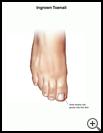
Ingrown Toenail: Brief Version
What is an ingrown toenail?
An ingrown toenail is when the corner of a toenail grows into the skin around it. It makes your child's toe tender, red, and swollen. It is usually caused by tight shoes.
How can I take care of my child?
- Soak the toe. Soak the foot for 20 minutes twice a day in warm water and antibacterial soap. While the foot is soaking, massage the swollen part of the cuticle away from the nail.
- Use antibiotic ointment. Put an antibiotic ointment on the toe to the swollen part of the toe after soaking. You can buy this ointment without a prescription.
- Cut off the corner of the toenail. The pain is usually caused by the corner of the toenail rubbing against the raw cuticle. Your doctor will cut this corner off. Your doctor only needs to do this only once. This helps the nail grow over the nail cuticle rather than get stuck in it. During soaks try to bend the corners of the nail upward. Then keep it raised with a wedge of cotton
- Don't wear shoes. Have your child wear sandals or go barefoot a lot. This helps keep pressure off of the toenail until it heals.
- Use a cotton ball. When your child must wear closed shoes, you can protect the ingrown toenail this way:
- If the inner edge of the toenail is hurt, tape a foam pad or a cotton ball between lower part of the first and second toes to keep the upper toes from touching.
- If the outer edge is hurt, tape a foam pad or a cotton ball to the outside of the ball of the lower toe to keep the toenail from touching the side of the shoe.
How can I prevent ingrown toenails?
Make sure that your child's shoes are not too narrow. Give away any pointed or tight shoes. Cut the toenails straight across, so that you can see the corners. Cut the toenails every week.
Call your child's doctor right away if:
- Your child develops a fever.
- A red streak spreads beyond the toe.
Call your child's doctor during office hours if:
- Any pus or yellow drainage is not cleared up after 48 hours of treatment.
- The cuticle has not totally healed in 2 weeks.
- You have other concerns or questions.
Written by Barton D. Schmitt, MD, author of “My Child Is Sick,” American Academy of Pediatrics Books.
Pediatric Advisor 2018.1 published by Change Healthcare.
Last modified: 2012-05-15
Last reviewed: 2017-06-05
Last modified: 2012-05-15
Last reviewed: 2017-06-05
This content is reviewed periodically and is subject to change as new health information becomes available. The information is intended to inform and educate and is not a replacement for medical evaluation, advice, diagnosis or treatment by a healthcare professional.
Copyright ©1986-2018 Barton D. Schmitt, MD FAAP. All rights reserved.

